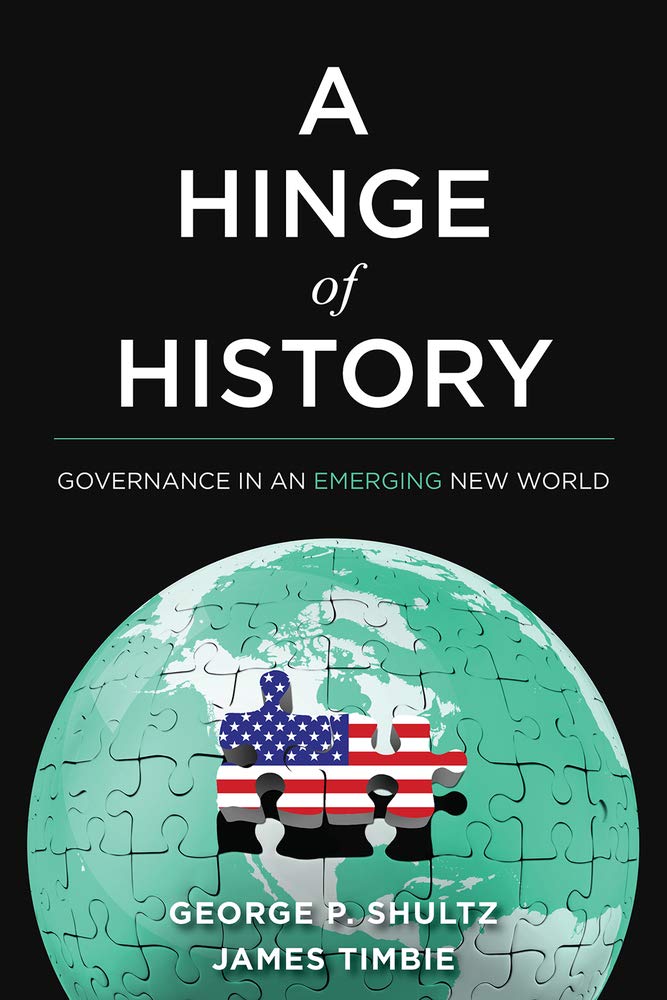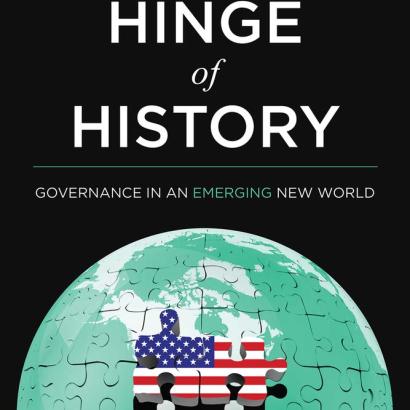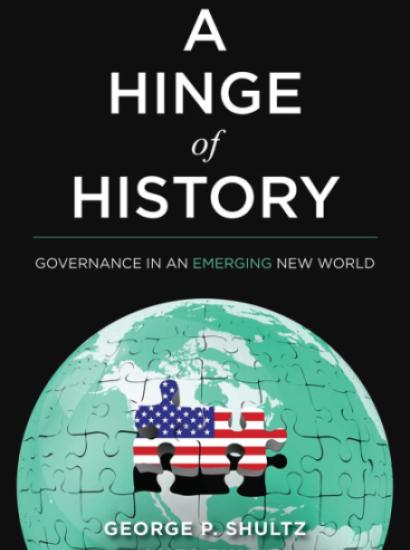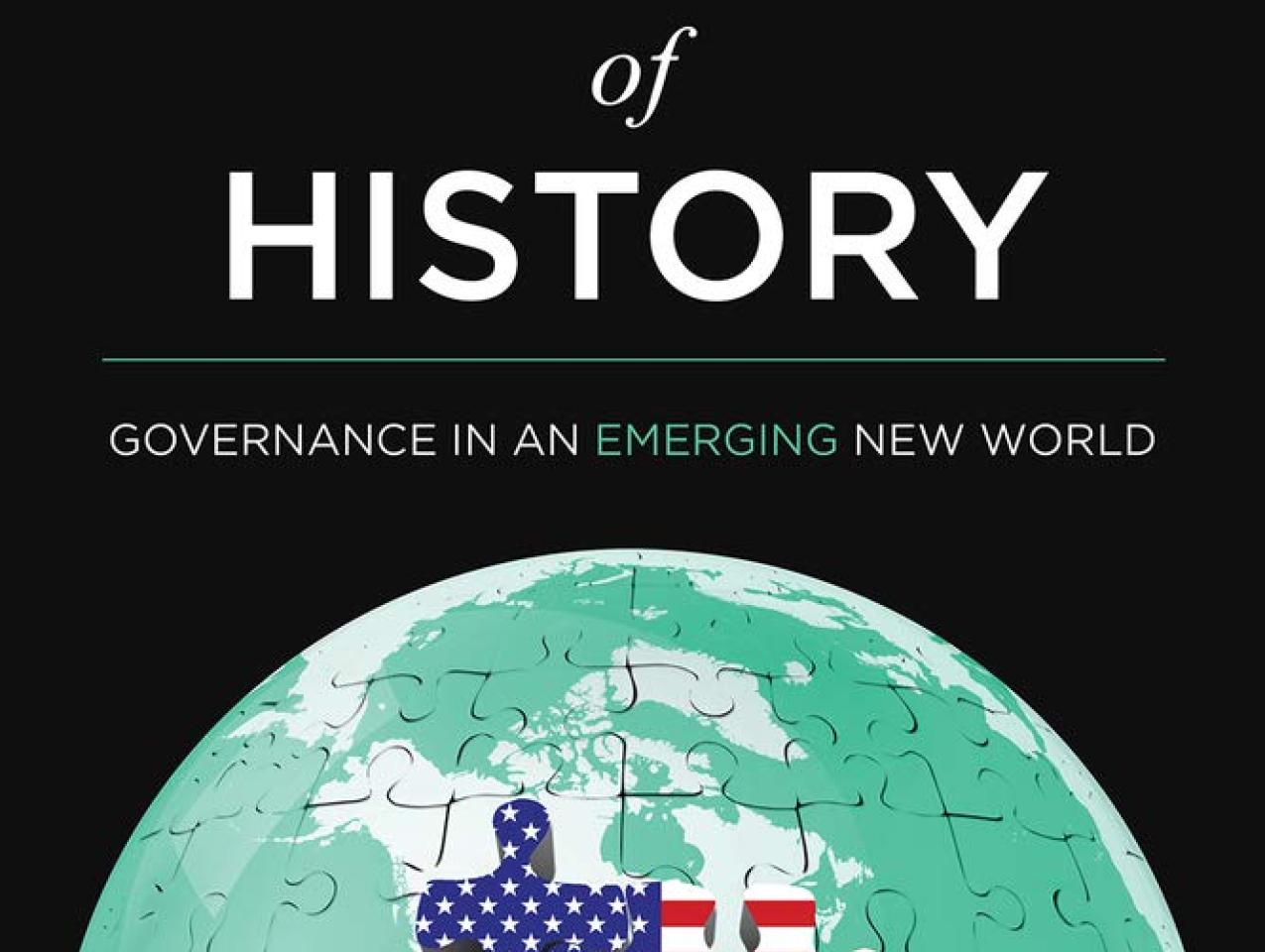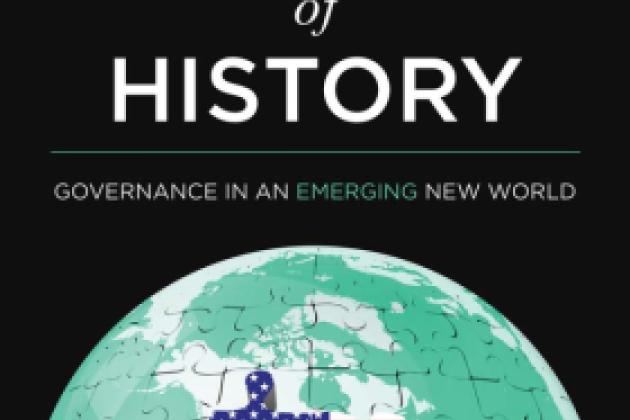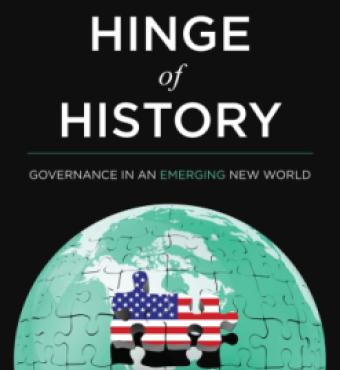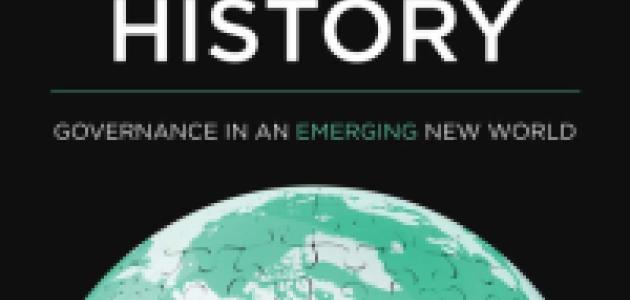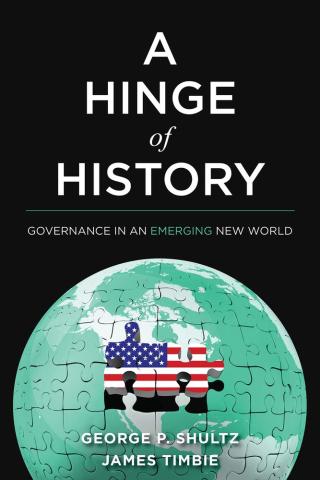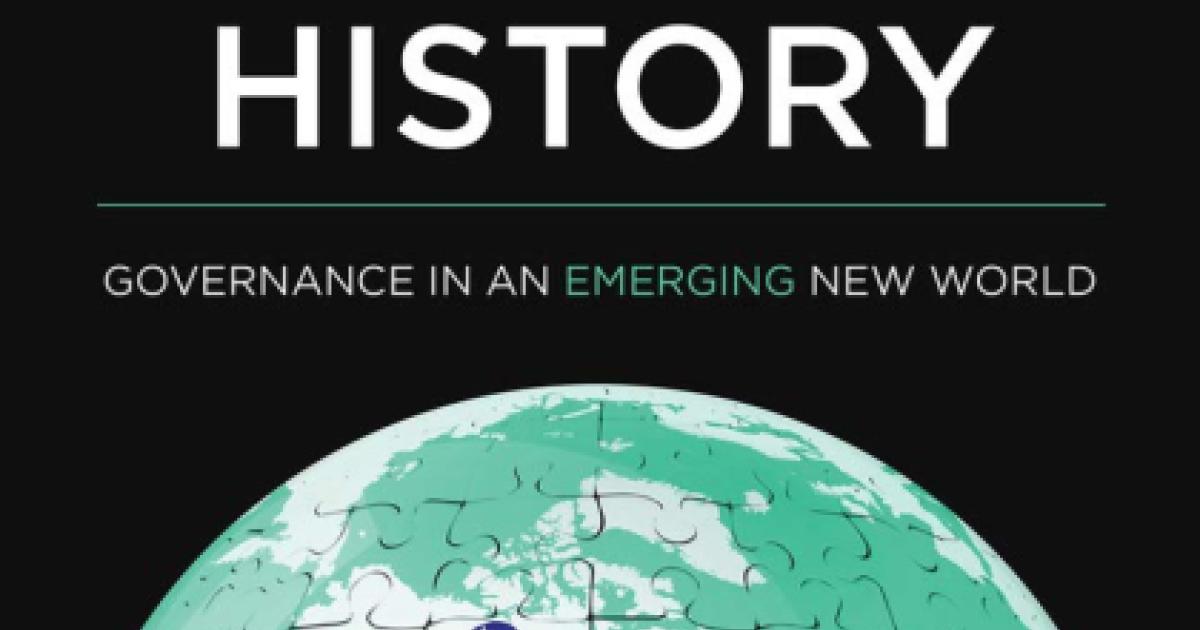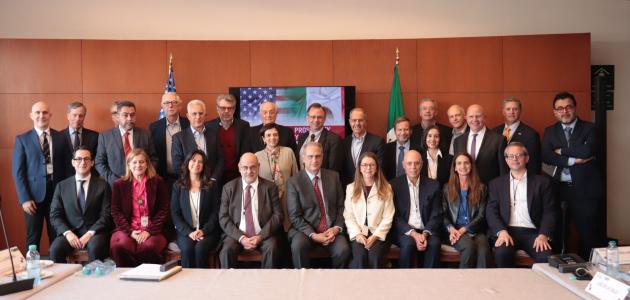by Jonathan Movroydis
In this interview, Thomas W. and Susan B. Ford Distinguished Fellow George P. Shultz and Annenberg Distinguished Visiting Fellow James Timbie discuss their new book A Hinge of History: Governance in an Emerging New World. The conversation also features Adele Hayutin, Annenberg Distinguished Visiting Fellow and a contributor to the book, who offers insights into global demographic trends.
Shultz, Timbie, and Hayutin explain how the world has reached an inflection point. The political and economic architecture built after World War II is eroding. Rapidly advancing technology and radically shifting demographic trends are posing major challenges to world order, institutions, and stability. The authors argue that in order to mitigate the problems and take advantage of new opportunities, America must take a global leadership role, work with allies, and even find common ground with competitors.
What do you hope to accomplish by the publication of A Hinge of History?
George P. Shultz: We are on a hinge of history. Change is taking place radically and rapidly. The near future is not going to be like the near past. It’s comparable to the period right after World War II, when President Harry Truman and General George Marshall looked back at the first half of the twentieth century. What did they see? They saw two world wars. They saw a holocaust. They must have said to themselves, “What a crummy world.” Truman and Marshall came to the realization that America is part of the world, whether we like it or not. America provided leadership in establishing a political and economic order that has served the world well. That order is now eroding. The United States again is facing a similar inflection point and needs to again step up as a global leader.
James Timbie: The overall objective of A Hinge of History is to first understand new global forces and then suggest the best way to take advantage of opportunities, to capture the benefits from changing demographics and advancing technologies, and to mitigate potential problems. Most countries are facing these same challenges, and we see a need for leadership from the United States. We see great potential for working with allies, partners, friends, and even competitors. We also need to improve K–12 education and retrain our work force to adapt to emerging technologies such as artificial intelligence, 3D printing, and other manufacturing techniques that are transforming our economy, democracy, and national security. For this project we also addressed cross-cutting issues of climate change and nuclear proliferation.
We see a need for international cooperation and US. leadership to guide us through this period of promise and problems to secure peace and prosperity in the decades to come. And we want to highlight the challenges of governing over diversity in today’s information age.
Adele Hayutin: The pace of change is faster than ever before, but the nature of the change is different. It’s not an extrapolation of past trends. It’s a combination of the past trends coming together in a way that we haven’t seen before. One of the world’s biggest challenges is shifting demographic trends. Basically, all advanced countries have low fertility and rising longevity rates, and thus are losing their working-age population. These countries include China, Russia, Japan, Australia, Canada, and the United States. At the same time, there are booming population growth rates in the world’s developing regions, where resources are scarcer.

You write that changes are afoot throughout the globe. Are these changes epochal? How do they differ from previous eras of change, including the end of the Second World War and the end of the Cold War?
Timbie: There are precedents for big, global changes—the introduction of steam power and electricity, and the devastation of World War II, for example. What is different today is the speed of change. Today’s change is happening quickly. Workplaces are disrupted by artificial intelligence, the rise of social media connects people worldwide, and societies are struggling to support aging populations with shrinking workforces while others are young and growing rapidly without promising economic prospects. When agriculture was mechanized in the early twentieth century, it was enough to educate the children of the farmers to take up new occupations in the city. Now current workers themselves need training and education to adapt to a changing workplace.
Does the United States have the institutions and resources to deal with these emerging challenges and take advantage of these new opportunities?
Timbie: Adapting to change is a difficult challenge everywhere, but the United States has advantages and is well positioned to reap the benefits and mitigate the problems. Our industries and universities are at the forefront of leading-edge technologies. Talented people are attracted to the United States from all over the world, and our tradition of immigration allows us to maintain the size of our workforce even as we age.
We can look forward to increased productivity, a stronger economy, higher-quality health care at lower cost, and a better standard of living. Workers will need new skills to master new or redesigned jobs and will have to change careers more frequently. We know how to do that; community colleges that have partnered with local employers have proven how to provide training to support transitions to new occupations. The social safety net can be adapted to support these transitions as well. The biggest problem we see is correcting the shortfall in K–12 education.
What are the geopolitical challenges that are emerging as a result of these demographic shifts?
Hayutin: China’s aging population and shrinking workforce will negatively impact its economic growth. In the past, the migration of Chinese workers from rural to urban areas propelled economic growth. They made great strides and lifted millions of people out of poverty. Today, that trend is gradually disappearing.

The legacy of the one-child policy puts lots of challenges on the caregiving system of the family. Decreasing family sizes means that there’s no support structure to take care of older populations. Family sizes declined, on average, to one child, two adults, and four grandparents. As a result, there is much less filial piety. The Chinese custom of children taking care of their parents has been challenged. This has also become a trend throughout all of Asia.
One of the other interesting geopolitical issues is the emergence of India. While China has had a steep fertility decline, India has had a much slower decline in fertility rates and continues to grow its population and economy. It doesn’t yet have China’s economic strength, but it has the potential to vastly improve its economic prospects.
Timbie: There are various ways these challenges can be managed. Countries with aging populations and shrinking workforces can look to new productivity-increasing technologies to help promote economic well-being across all age groups. Meanwhile, countries with young, growing populations need strong educational systems, particularly for women and girls, and growing economies to foster reduced fertility rates and more job opportunities.
Migration, managed with respect for the rule of law and the interests of all citizens, can benefit both the countries with young, growing populations and countries with aging populations. We should expect migration and prepare for it—including, as I mentioned, supporting education in developing countries.
What are the demographic challenges of some of America’s allies (especially in Europe) and competitors (China and Russia)? How should US leaders view the challenges of these countries and deal with their own?
Timbie: Our allies in Europe, and in Japan and South Korea, face the need to support aging populations with shrinking workforces. Technology can help, by increasing productivity. Immigration can also help, by bringing in young workers from countries where the working-age population is growing faster than job opportunities.

China’s working-age population has peaked and begun a steady decline. China will not be able to sustain the economic growth of the past, even as it embraces technology to increase productivity. Russia is also facing a shrinking workforce, and many young and well-educated people leave for more promising opportunities elsewhere, including Silicon Valley.
Our allies and friends are enormous assets, and we will be more successful if we work together to overcome the challenges we are all facing. We also see opportunities for productive cooperation with China and Russia, as we recognize their substantial economic and demographic problems as well as the national security threats they pose.
Hayutin: America’s advantage is that it’s the youngest of all large advanced economies. We have a growing population of young people, but we depend on immigration. A key issue for America’s strength and stability is whether or not we can revise our immigration policies so we can bring in the skills that we need. Another key issue is improving our K–12 system so we can leverage our economic advantages.
The United States should also address migration from countries that are distressed by climate change and low economic prospects. One idea would be to invest in the education and infrastructure of these countries, so that there is less incentive to migrate.
Shultz: We also have to remember that advancements in technology can bring us advantages. There are people who are resistant to technological change, but we have to fight against this pattern, because artificial intelligence [AI], 3D printing, and other innovations can create a lot of opportunities.
Another major issue of contentious debate is climate change. The fact is, our climate has changed and it keeps changing. One can see its effects, including the melting of ice caps in places like Greenland and the bleaching of coral reefs such as the Great Barrier Reef that is leading to the erosion of the fish supply.
Hayutin: There are two broad examples of the major geopolitical disruptions caused by climate change. One is the flow of refugees from Syria directed towards Europe, which, in addition to a civil war, resulted from five successive years of drought. The same is true of people migrating north from Central American countries, which were also impacted by drought and civil conflict. Both cases demonstrate a perfect storm of people wanting to search for better economic prospects.
How do AI and other emerging technologies shape the future of economics, politics, and conflict?
Timbie: Applications of artificial intelligence are disrupting industries throughout the economy. Some parts of nearly every job are now done better by machines. New technologies increase productivity and have great potential to make us more prosperous, more secure, healthier, better informed, and better citizens. They also raise problems, disrupting the workplace and creating security challenges. Many workers have been forced to learn new skills and find new occupations. This large-scale disruption of livelihoods has political consequences, which can be mitigated by supporting retraining, reskilling, and life-long learning, and facilitating transitions from one job to the next.
How can Americans shape K–12 education so that it can ensure adaptation by the future labor force to advanced technologies that are changing the pattern of work, and the strength of institutions integral to democracy?
Timbie: The shortfall in K–12 education is one of the biggest obstacles we face as we look forward to sustaining our economy and keeping pace with our competitors. A good primary and secondary education are essential to providing everyone with a solid foundation for the life-long learning and periodic reskilling necessary for success in the twenty-first-century workplace. In addition, education is absolutely necessary to the formation of citizenry in our democracy.
Decisions in education should be about what is best for the students, not what is best for the adults. Student performance should be the focus, not teacher credentials or the size of budgets. Transparency, accountability, and flexibility should be central principles, based on accurate data on student performance. Technology has not yet had the impact on improving K–12 education that it has had on many other industries; technology-enabled personalized learning could well be a major factor in the necessary improvement of K–12 education.
Another major trend addressed in the book is how technological innovation provides the capacity for more goods and services to be produced locally. What consequences might these innovations have on national economies and governance in individual countries?
Timbie: For the United States, 3D printing and other ways to produce goods near where they will be used consumed provides many benefits, including more choice, customized products, lower costs, and reshoring of jobs.
Countries in Asia pursuing manufacturing-led development could see potential disruption of their economies as their low-cost labor becomes less of an advantage. Private companies and governments could adapt by adopting new manufacturing technologies themselves, or identifying other areas of comparative advantage.
Given these advancements in technology, you write that there is also a trend toward diffusion of military power. Given this trend, what might a new paradigm of military conflict look like?
Timbie: We will be in uncharted territory in future conflicts. We can expect that conflicts could extend to space and cyberspace. We can expect increased reliance on artificial intelligence to support decision making. There’s a lot of potential for unintended consequences, and it’s very difficult to predict what the outcome is going to be in this new sort of conflict, where events could unfold very quickly.
New communication, space, and cyber capabilities are transforming the nature of conflict. They have enabled the development of smart, inexpensive, and lethal systems that can be produced in large numbers, strike with great precision, and threaten legacy systems. Our national security depends on taking advantage of these revolutionary technologies while meeting the challenges posed by such technologies in the hands of adversaries.
Future conflicts are likely to involve actions in space and cyberspace as well as on land, in the air, and at sea. Each side would seek to collect information and to establish secure communications while seeking to disrupt the information and communications networks of the other. The side with the most accurate information is likely to prevail. There could be a risk of miscalculation or misinformation leading to escalation and potentially the use of nuclear weapons.
Hayutin: The study of demographic trends helps us predict the potential consequences of the application of advanced technology in civil conflict. The more we understand our own demographics and those of allies and competitors, the better we can address political issues and resolve conflict.
How does the current media environment further complicate these challenges?
Timbie: Individuals worldwide can identify others of the same mind on social media and link up with them to oppose initiatives and obstruct the process of government.
Governments can seek to use technology to their advantage, but typically gridlock prevails. As one of our participants, the Wall Street Journal’s Daniel Henninger, succinctly summarized, “We can now stop anything we don’t want, but can’t enable anything we need.” We see this gridlock playing out in many countries. The best antidote is to adopt sound policies and strong leadership.
Social media has also greatly complicated governing over diversity, including increased political polarization and interference from foreign actors. Technology can also provide benefits, such as more efficient government services. The challenge for political leaders is to secure the benefits of advancing technology and mitigate the problems.
Shultz: The information revolution makes governance much more difficult, because everybody knows everything. The United States has a very diverse population. We have to understand how to govern over the diversity rather than allowing it to pull people apart. Here is an example of how to do it. San Francisco is a diverse city. There are seventy different foreign consulates. My wife is the chief of protocol for the city, and anytime the countries represented have a national holiday similar to the US fourth of July, she orders their flag to be flown at city hall and the playing of their national anthem. She also holds a ceremony for them. This demonstrates that the United States welcomes the contributions of other cultures and countries.
A long time ago, when I visited Israel, I met with the mayor of Jerusalem, Teddy Kollek. He took me to his office and said, “My job as mayor of Jerusalem is to make sure that it is a beautiful city. My job is to see that any one group in our diverse city can express themselves in a way that doesn’t prevent another group from expressing themselves.” Kollek wanted the citizens to achieve common ground, under what he called “the golden dome” of Jerusalem. I think that’s the message.
How has the COVID-19 pandemic made you think differently about these emerging challenges and how governments throughout the world are equipped to deal with them?
Timbie: The COVID-19 pandemic was not a surprise. As we say in the preface, in early April 2019, eight months before the virus emerged in Wuhan, one of our speakers presented a paper called “Potential Pandemics,” making clear that infectious diseases were making a comeback and that we were ill equipped to deal with a pandemic. This year has played out precisely as she predicted. And there will be more pandemics.
Like the other challenges we discuss, the COVID-19 pandemic is global and can only be addressed through international cooperation. Countries can mutually benefit by sharing information, learning from and supporting one another, jointly developing and producing therapeutics and vaccines, and preparing together to mitigate the next outbreak.
Large international organizations like the World Health Organization are cumbersome and make mistakes. The WHO did not manage the COVID-19 crisis well and gave undue deference to China. However, we should remain a member of the WHO and provide financial and technical support for its mission to improve public health globally, particularly in low- and middle-income countries.
We should not treat the availability of medical equipment, drugs, and testing supplies as a zero-sum game; international cooperation can help assure they are available when and where they are needed.
What are some other risks that could potentially disrupt world order?
Timbie: The reality of climate change and the risk of further proliferation of nuclear weapons have clear potential for disruption.
Climate change is having an observable impact. Infectious diseases are moving north, and ecosystems and resources are being damaged. The best policies to reduce emissions on the necessary scale include a revenue-neutral carbon tax, and investments in the development and use of technologies for clean energy and carbon removal.
Nuclear weapons pose a unique threat, particularly ominous when viewed within the complex environment of advanced conventional systems and new competition in space and cyberspace. Further proliferation of nuclear weapons is a worrisome threat. Even a “regional” nuclear conflict would have global consequences.
How can the United States be a leader in solving these challenges and reinforce global stability?
Timbie: The challenges we face are global and can only be addressed through international cooperation. Traditionally, the United States has played a leadership role, encouraging the development of frameworks that benefited the United States but also allowed for the success of others.
Our ability to resume a leadership role will depend on sustaining our position at the forefront of transformational technologies, sustaining our military strength, and getting our fiscal house in order. Wise policies at home will strengthen our ability to provide leadership abroad.
Most countries face the same challenges we do, and there is great potential for proceeding in partnership to address them. This not only includes working with our allies, who are big assets in addressing global challenges, but with our competitors as well.
Shultz: The security framework that was provided by the United States after World War II was not a win-lose proposition. It wasn’t a zero sum. It was building a system in which both the United States and the rest of the world could benefit. This the key principle in which we think about today’s challenges.







